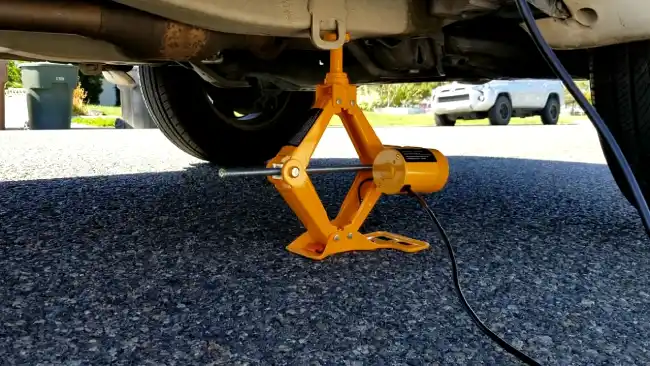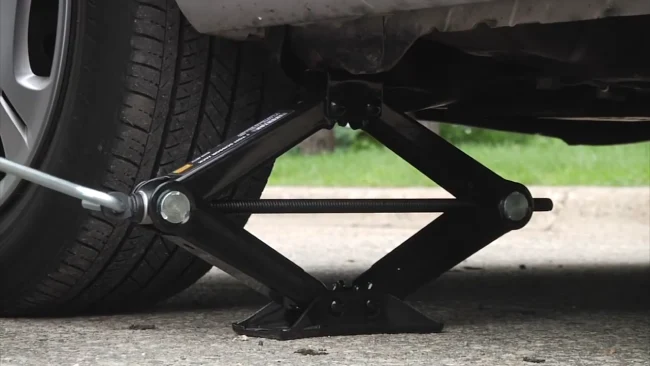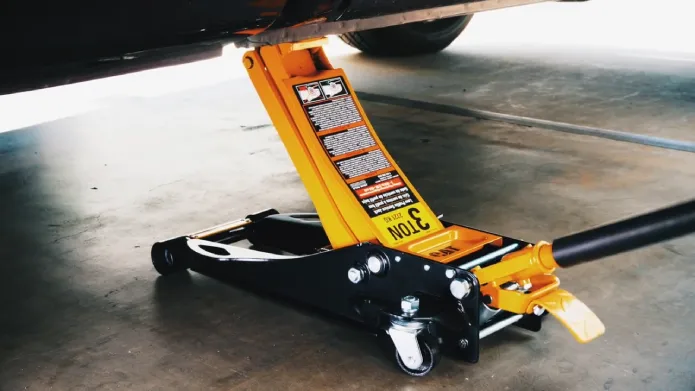Last Updated on July 9, 2023
If you’re a car owner, you know that a car jack lift is a tool you can’t do without. Your car can be lifted off the ground with this piece of equipment so you can change a tire, check the brakes, or do other maintenance. But have you ever wondered how much weight a car lifting jack can lift?
The smallest jack lifts are designed to hold about one ton of weight and are only suitable for mini compact cars. If you have a passenger car, you’ll need a lifting jack that can handle at least two tons of weight.
Today we’ll explore the weight limits of car jacks, how to choose the appropriate one for your vehicle, and the safety precautions you need to take when using a car jack. So, fasten your seat belts, and let’s dive into the world of car jacks.
How Much Weight Should a Car Jack Lift?

Choosing a jack that can lift 75% of your vehicle’s weight is recommended to ensure safe lifting. For example, a 2-ton jack is sufficient for a full-size family car, but a larger vehicle such as an SUV or 4×4 may require a jack with a minimum of 3 tons capacity.
Therefore, select the right jack for your vehicle. Use caution when lifting a vehicle with a jack, and never exceed the recommended weight limit.
How to Choose a Proper Car Jack Lift for Your Vehicle?

Car jack lifts shouldn’t just be chosen for their weight capacity. Aside from the size and shape of your vehicle, you should also consider what kind of work you will be doing. A car jack lift that can’t handle the weight of your car can be dangerous and lead to accidents.
When choosing a car lifting jack for your vehicle, there are several key points to consider.
Consider the Weight Capacity:
Before you choose a car jack lift, check its weight capacity to ensure your vehicle is safely supported. The weight capacity of a car jack lift refers to the maximum weight it can lift. Using a jack with a lower weight capacity than your vehicle’s weight can potentially fail, causing serious damage or injury.
Here are three things to keep in mind when considering the weight lifting capacity of a car jack:
- Always choose a jack lift with a weight capacity that exceeds your vehicle’s weight. Choosing a jack lift that can handle more weight than you need is better.
- Consider the weight of any accessories or modifications you’ve added to your vehicle. These can add significant weight and affect the overall weight capacity of the jack you choose.
- Make sure the weight capacity of the jack lift is marked and visible. Don’t rely on assumptions or guesswork when choosing a jack that can safely lift your vehicle.
Evaluate the Jack Lift Type:
When evaluating the jack lift type, you’ll want to consider your priorities. Are you looking for stability or portability?
Hydraulic floor jacks are more stable and offer quicker lifting, making them a great option for heavier vehicles or frequent use. They use hydraulic pressure to lift the car, requiring less physical effort from you. But they are also larger and heavier, so they may not be as easy to move around or store.
Conversely, scissor jack lifts are typically smaller and more portable. They are great for emergencies or occasional use but may not be as stable as hydraulic floor jacks. They use a mechanical screw to lift the car, requiring more physical effort from you.
A scissor jack might be a good choice if you have a smaller or lighter vehicle and don’t need to lift it very high.
Assess the Lifting Height:
You envision yourself comfortably standing under your vehicle as you work. It is important to determine your lift’s ideal height and find a jack that can easily reach it.
To assess the lifting height required, measure the distance from the ground to the lowest point of your vehicle that needs to be accessed. Add a few inches to this measurement to allow for clearance and ensure you have enough space to work comfortably.
Once you have determined the lifting height required, make sure your car jack lifts can lift your vehicle to that height. Check the jack’s maximum lifting height and compare it to your desired height.
Examine the Construction Quality:
To ensure your lift’s safety and reliability, examine the car jack’s construction quality. A sturdy jack lift should be made of steel or aluminum, which can withstand heavy usage.
Weld quality and durability are also crucial factors to consider. Poor construction quality can lead to accidents or failures during lifting, causing serious injuries or damage to your vehicle.
Also, a well-constructed jack lift should provide ease of use and convenience. Consider the size and weight of the jack, as well as its storage and portability.
A car jack that is too heavy or bulky may be difficult to store or transport, which can be a hassle when you need to use it. In this regard, assess the construction quality of the car jack while also considering its portability and storage.
Consider Portability and Storage:
Consider a compact and lightweight option if you’re looking for a car jack that’s easy to transport and store. Because these portable jack lifts are perfect for people with limited storage space or who need to carry them around. They are also easy to maneuver so you can use them in tight spaces without hassle.
Check for Additional Features:
Take a closer look at any extra features that may come with the portable option you’re considering, as they can greatly enhance the safety and convenience of your car-jacking experience.
Here are four features to consider:
- Safety overload system: This feature prevents the jack lift from lifting more weight than it’s designed for, which can help prevent accidents and damage to your vehicle.
- Locking mechanism: A locking mechanism can keep the jack in place while you work on your vehicle, providing additional stability and safety.
- Rubber pad: A rubber pad on the jack lift can help protect your vehicle’s frame from damage while providing additional grip to prevent slippage.
- Storage case: Many portable car jacks come with a storage case, making transporting and storing the jack easier when not in use.
Which types of car lifts are available?

When choosing a car jack, it’s important to consider the different types available.
Scissor Jack Lifts
You’ll be surprised at how high a scissor jack can raise your vehicle with just a few turns of the handle. These jacks are compact and easy to use, making them a popular choice for emergency situations. They use a screw mechanism to lift the vehicle, with the scissor design providing stability and support.
Here are three things to remember when using a scissor jack:
- Always ensure the jack is placed on a flat and stable surface.
- Use the jack only on the designated jacking points of your vehicle.
- Never crawl under a vehicle that’s supported only by a scissor jack.
Hydraulic Floor Jack Lifts
Hydraulic floor jack lifts are a popular choice for those in need of a heavy-duty option for vehicle lifting. These jacks use a hydraulic system to lift the vehicle, making it easy to lift and lower heavy loads with minimal effort.
The hydraulic floor jack lift consists of a large cylinder that contains hydraulic oil, a pump, and a piston. When you pump the handle, the oil is forced into the cylinder, pushing the piston up and lifting the vehicle.
One of the benefits of hydraulic floor jacks is their ability to lift heavier loads than scissor jack lifts. Depending on the model, hydraulic floor jacks can lift anywhere from 1.5 to 20 tons. They are also more stable than scissor jacks, making them safer for lifting larger vehicles.
Bottle Jack Lifts
Now that you know about hydraulic floor jacks, let’s move on to bottle jack lifts. These jack lifts are smaller and more compact than hydraulic lifts, so they are a popular choice among car owners with limited space.
Bottle jacks use a hydraulic ram to lift the car, placed on top of a cylinder-shaped structure. The jack lift is operated by a lever that controls the hydraulic pressure, allowing you to lift the car to the desired height.
One of the benefits of using a bottle jack is that they can lift heavy loads, with some models able to lift up to 50 tons. However, note that the weight capacity of a bottle jack varies depending on the model, so it’s essential to check the weight limit before using it to lift your car.
Pneumatic Car Jack Lifts
A pneumatic car jack might be the perfect solution if you’re looking for a faster and more efficient way to raise your vehicle. These lifts use compressed air to lift your car, allowing you to quickly and easily change a tire or perform other maintenance underneath.
Unlike bottle jack lifts requiring manual pumping, pneumatic jacks can lift your car in seconds. One thing to remember when using a pneumatic jack is that they require a compressed air source. This means you’ll need an air compressor on hand to power the jack.
What safety precautions to follow when using a car jack lift?

When using a car jack, follow the instructions and use jack stands to secure the vehicle before you start working on it:
- Place the car jack properly under the vehicle, following the instructions in the owner’s manual or using a sturdy structure of the vehicle’s undercarriage.
- Never go under a vehicle supported only by a car jack, as it can fail unexpectedly and cause serious injury or death.
- Also, inspect the car jack before each use to ensure it’s in good condition. Check for cracks, rust, or leaks, and make sure the hydraulic fluid is appropriate.
- Be mindful of the weight capacity of the car jack and never exceed it. Always use a car jack that is rated for the weight of your vehicle.
How much weight can I lift with a 2-ton jack?
A 2-ton car jack lifts a maximum capacity of 4,000 lbs, capable of lifting most cars and small trucks. But remember that lifting the maximum weight on the jack is not recommended.
It’s always better to be safe than sorry, so check the weight of your vehicle before using a 2-ton car jack. You can find the weight of your vehicle in the owner’s manual or by searching online.
Elevate Your Car with Confidence: Choose the Right Car Jack Lift
Now you know the maximum weight capacity of a car jack lift and how to choose the proper one for your vehicle. Remember always to follow safety precautions when using a car jack, such as using jack stands and never working under a car only supported by a jack.
Whether you need to change a tire or perform maintenance on your car, a car jack is an essential tool. By understanding the weight capacity of different jack lifts and following proper safety procedures, your car will be lifted safely and effectively.
